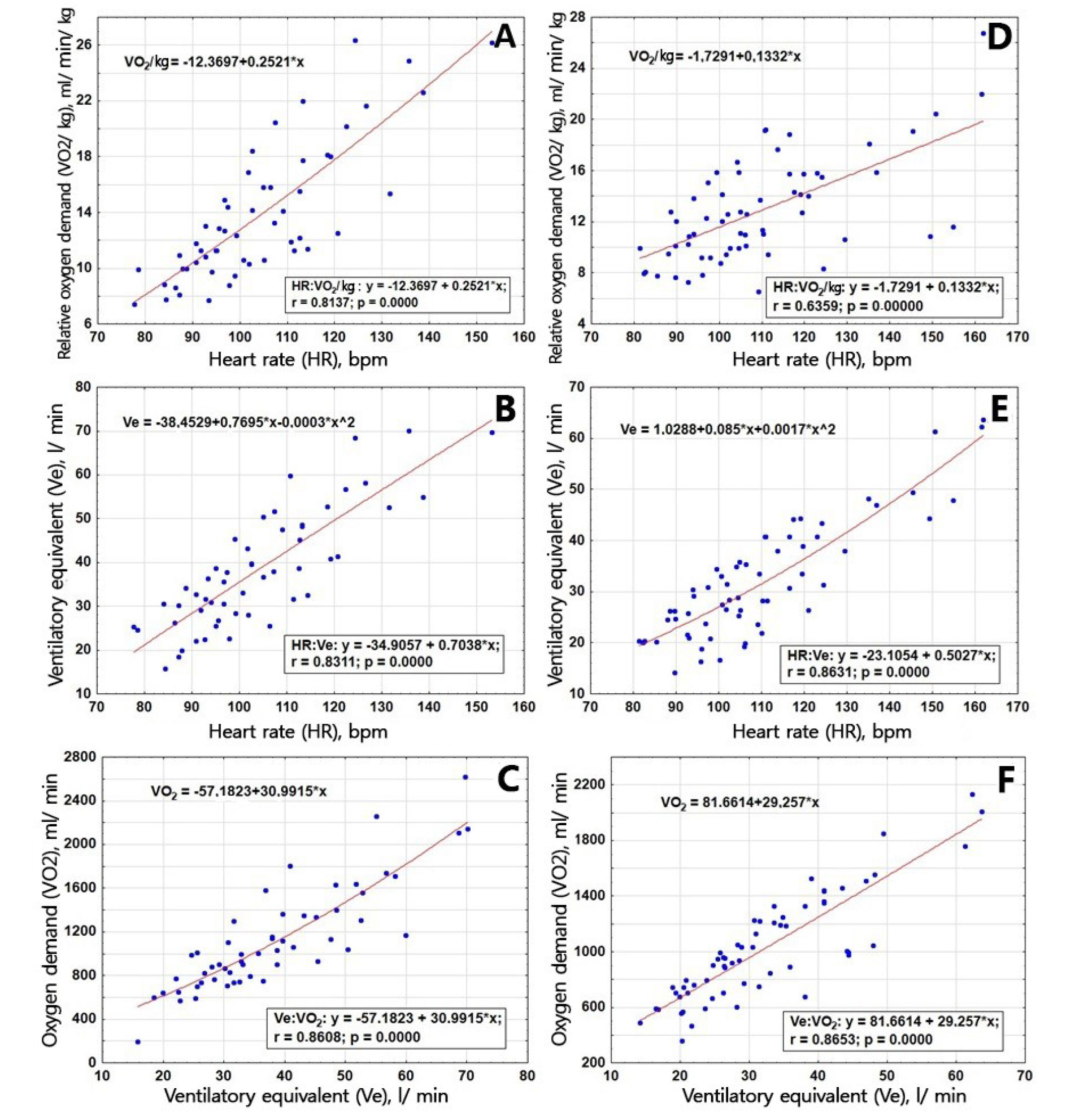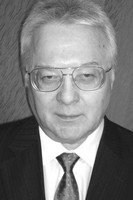Effects of varied-pace walking practices on cardio-respiratory system functionality rates of senior residents of Yugra North
Фотографии:
ˑ:
Dr.Biol., Professor S.I. Loginov1
S.G. Logvinova2
PhD A.S. Kintyukhin1
1Surgut State University, Surgut
2Lyceum no. 3, Surgut
Keywords: varied-pace walking, treadmill, HR, oxygen demand, ventilator equivalent, linear regression equation.
Introduction. Adequate bioenergetic functioning is the basis of normal physiological aging [4]. The main patterns of bioenergetic changes under physical load were determined more than 50 years ago [3]. In particular, it was found that the ventilatory equivalent (Ve) rate can act as an indirect indicator of energy demand, since Ve and oxygen demand (VO2) have a clear correlation, which is expressed by the formula: VO2=Ve×exO2-exO2, where exO2 – the expiratory oxygen rate. In case the moderate intensity work lowers the ventilatory equivalent rate by more than 50 l/min, then the man’s VO2 and Ve rates start bearing a linear relationship [5]. Today, we have proved these patterns in young and middle-aged people [1, 2] and would like to test them in a random sample of seniors in the uniform methodological conditions of laboratory research, taking into account the specific climatic conditions of the Yugra North and reduced physical activity of a person.
Objective of the study was to reveal the patterns of influence of aerobic load in the form of varied-pace walking on the cardio-respiratory system functionality rates of senior residents of the Yugra North.
Methods and structure of the study. Subject to the study were senior permanent residents of the Yugra North (n=24 including 11 males and 13 females aged 68.2±5.1 years). Neither of the participants was diagnosed with contraindications for physical tests, and every subject gave his/ her informed consent for the tests prior to the experiment. The interval (5 min) Torneo treadmill walking tests at 2, 3, 4, 5, 6 and 7 km/h walking speeds were independent variables. The test sessions took 30 min on the whole. СOSMED (Italy-made) Fitmate Pro metabolimeter was used to test the respiratory system performance and basal metabolism. The dependent variables were presented by the respiratory frequency (RF, number of breaths per minute), ventilatory equivalent (Ve, l/min), oxygen demand (VO2, ml/min) and relative oxygen demand (VO2rel, ml/min/kg) rates, heart rate (HR, bpm), expiratory oxygen rate (exO2, %). The VO2, Ve and HR data were averaged every 15 sec, downloaded to the computer for presentation and stored in the database for further detailed analysis. Prior to the tests, leg length (cm), body height (cm) and body mass (kg) data were obtained. The baseline data were processed using the statistical tools of Statistica v.10 software package (StatSoft, USA), followed by preliminary normality assessments and calculations of the mean arithmetic value (Х), mean square deviation (SD), 0.95-level confidence interval (±0,95 CI) and data correlation and regression analyses. A two-way t-test of the correlated and non-correlated groups was used to rate the significance of differences, with the difference rated significant at p≤0.05.
Results and discussion. The study group was made of senior men and women (68.2±5.1 years) permanently residing in KhMAD-Yugra in Surgut and Surgut region. The anthropometric measurements of men differed by higher body height rates only (Table 1).
The VO2, HR and Ve rates were found to significantly grow (t-test, p<0.05) with the growing pace starting from 3 km/h. At the speed of 4 km/h and more, the rest of the rates increased statistically significantly, with the expiratory oxygen rate showing no significant variations (Table 2).
Table 1. Anthropometric measurements of the senior people surveyed (n=24), X±SD
|
Parameters |
Men, n=11 |
Women, n=13 |
Total, n=24 |
|
Age, years |
66.7±4.3 |
65.5±5.8 |
66±5.1 |
|
Body height, cm |
1.74±0.08 |
1.63±0.077* |
1.68±0.097 |
|
Body mass, kg |
77.8±12.9 |
78.2±12.5 |
78±12.4 |
|
BMI, kg/m2 |
26.4±3.9 |
28.6±4.3 |
27.6±4.2 |
|
Leg length, cm |
0.83±0.013 |
0.83±0.051 |
0.83±0.095 |
* – men versus women data difference significant at p<0.05
Table 2. Cardiorespiratory system performance variation in seniors with walking speed in the treadmill test (n=24), X±SD
|
Rate |
Walking speed, km/h |
|||||
|
2 |
3 |
4 |
5 |
6 |
7 |
|
|
RF, br/min |
22.7±4.6 |
23.7±4.3 |
25.7±5.1* |
27.2±5.1* |
28.4±5* |
33.6±5.5* |
|
HR, bpm |
90.8±8 |
97.4±9.2* |
105.1±11.8* |
114.4±13* |
122±12.3* |
143±15.4* |
|
Ve, l/min |
23±5 |
28.1±6.3* |
33.3±7.1* |
39.7±8* |
46.3±6.8* |
63.3±6.1* |
|
VО2, ml/min |
694.7±196 |
849.7±204* |
1003±246* |
1196±275* |
1484±339* |
1973±388* |
|
VО2rel, ml/kg/min |
9.1±1.5 |
10.8±1.7* |
12.7±2* |
14.8±2.6* |
18.1±3* |
23±3.9* |
|
exО2, % |
17.3±0.9 |
17.2±0.7 |
17.2±0.7 |
17.2±0.8 |
16.9±0.7 |
17.0±0.5 |
* – the differences are significant at p<0.05 versus the data obtained at the speed of 2 km/h
The oxygen demand rate in the senior men and women correlated with HR (r=0.8137, p=0.0000 and r=0.6359, p=0.0000, respectively), which was described by the following equation: VO2=-12.4+0.25 HR and VO2=-1.73+0.13 HR, respectively, where VO2 - oxygen demand (ml/kg/min) and -12.4 and -0.13 - empirical coefficients (see Figures A, D).
The study also found a clear correlation between the ventilatory equivalent rate (Ve) and heart rate (HR), described by the equation as follows: Ve=-34.9+0.7 HR (r=0.8311, p=0.0000) for men and Ve=-23.1+0.5 HR for women (r=0.8631; p=0.0000) (see Figures B, E).
The ventilatory equivalent rate variation with the oxygen demand rate was described by the following linear regression equation: VO2=-57.2+31 Ve (r=0.8608; p=0.0000) for men and +VO2=81.7+29.3 Ve (r=0.8653; p=0.0000) for women (see Figures C, F).

Figures A-F. Relative oxygen demand rate (VО2rel, ml/ kg/ min) variation with heart rate (HR, bpm) in the 2-7 km/ h treadmill walking tests of senior men (А) and women (D), ventilatory equivalent (Ve) – with heart rate (HR) (B) and (E), VO2 – with Ve (C) and (F), respectively
The data in Figures indicate that the ventilator equivalent rate in seniors during varied-pace walking on a treadmill is virtually similarly closely correlated with VO2 (r=0.86, p=0.0000) and heart rate (r=0.83; p=0.0000).
Physical activity dominated by the contractions of the striated muscles claims the highest energy costs [5, 6, 10]. At the same time, precise measurements of energy costs of physical activity are still challenging, particularly in cases of irregular physical activity [9]. In order to precisely rate energy costs of physical loads, it is necessary to know the oxygen demand per time unit per 1 kilo of body mass, which cannot be done without special-purpose equipment. In this context, we can use the ventilatory equivalent rate, since it is as closely connected with the oxygen demand variations as it is with the HR under varied-intensity physical loads.
The above correlation can be described by the following equations: Ve VО2=-57.2+31 (r=0.8608; p=0.0000) for men; and VО2=81.7+29.3 Ve (r=0.8653; p=0.0000) for women. Similar data were obtained in other two studies, during which we used the 6 minute treadmill walking tests to find the VО2 rates being in close correlation with the ventilatory equivalent rates Ve (r=0.94; p<0.001) as described by the following linear regression equation: VО2=63.2+44.1 Ve, where VО2 - oxygen demand (ml/min), Ve - ventilatory equivalent (l/min), and 63.2 and 44.1 - empirical ratios [7, 8].
Conclusions. The regression equations factoring in the study data may be applied to control and manage physical loads in the health improvement practices in application to the senior residents of the Yugra North. We recommend the lung ventilation being rated per 1 min by a dry spirometer followed by the rate being used to compute the oxygen demand rate using the above formulae.
The study was performed with the financial support from the Russian Foundation for Humanities, Russian Foundation for Basic Research and the Education and Youth Policy Department of the Khanty-Mansi Autonomous Region-Yugra under the “Senior Urban Population of the Siberian North (KhMAR-Yugra) Physical Activity Optimization” Project #16-16-86006.
References
- Loginov S.I., Kintyukhin A.S., Malkov M.N. et al Vliyanie khodby s raznoy skorostyu na pokazateli kardiorespiratornoy sistemy studentov v usloviyakh Yugry [Effects of variable-speed walking practices on cardiorespiratory system performance rates in Yugra students]. Teoriya i praktika fiz. kultury, 2016, no. 9, pp. 86–88.
- Loginov S.I., Kozlova V.V., Gorlenko V.A. et al. Vliyanie fizicheskikh uprazhneniy na parametry kardiorespiratornoy sistemy zhenschin i muzhchin vtorogo zrelogo vozrasta v usloviyakh KhMAO-Yugry. [Effect of physical exercises on cardiorespiratory characteristics of women and men in second adulthood in conditions of KhMAR-Yugra]. Teoriya i praktika fiz. kultury, 2013, no. 11, pp. 88–92.
- Astrand P.-O., Saltin B. Maximal oxygen uptake and heard rate in various types of muscular activity. J. Appl. Physiol., 1961, vol. 16, pp. 977-981.
- Berryman N., Bherer L., Nadeau S., Lauzière S. Lehr L., Bobeuf F., Kergoat M.J., Vu T.T., Bosquet L. Relationships between lower body strength and the energy cost of treadmill walking in a cohort of healthy older adults: a cross-sectional analysis. Eur. J. Appl. Physiol., 2017, vol. 117. No. 1. P. 53–59. doi: 10.1007/s00421-016-3498-4.
- DeLani J.P., Kelley D.E., Hames K.C., Jakicic J.M., Goodpaster B.H. Effect of physical activity on weight loss, energy expenditure, and energy intake during diet induced weight loss. Obesity (Silver Spring), 2014, vol. 22, no. 2, pp. 363-370. Doi: 10.1002/oby.20525.
- Fair A.M., Montgomery K. Energy balance, physical activity, and cancer risk. Methods Mol. Biol., 2009, vol. 472, pp. 57-88. doi:10.1007/978-1-60327-492-0_3.
- Gastinger S., Nicolas G., Sorel A., Sefaty H., Prioux J. Energy expenditure estimate by heart-rate monitor and a portable electromagnetic coils system. Int. J. Sport Nutr. Exerc. Metab., 2012, vol. 22, no. 2, pp. 117-130.
- Gastinger S., Sorel A., Nicolas G., Gratas-Delamarche A., Prioux J.A Comparison between Ventilation and heart Rate as indicator of Oxygen Uptake during Different intensities of Exercise J. Sports Sci. Med., 2010, vol. 9, no. 1, pp. 110-118.
- Saltin B., Astrand P.-O. Maximal oxygen uptake in athletes. J. Appl. Physiol., 1967, vol. 23, no. 3. P.353-358.
- Wasserman K., Beaver W.L., Whipp B.J. Gas exchange theory and the lactic acidosis (anaerobic) threshold. Circulation, 1990, vol. 81, pp. 14-30.
Corresponding author: logsi@list.ru
Abstract
Subject to the study were senior permanent residents of the Yugra North (n=24 including 11 males and 13 females aged 68.2±5.6 years). The study was designed to analyze benefits of treadmill walking practices with paces varying within 2-7 km/h and stepped by 1 km/h. The oxygen demand (VO2 ml/min) rate, minute ventilation (Ve, l/min) rate, exhaled oxygen (КО2, %) and heart rate (HR, beats per min) were obtained using FitmatePro Metabolograph and a HR test system. The tests found the above rates growing with the growing pace (t test, p<0.05), with the only exclusion for КО2. We also found a close correlation of Ve with VO2 in the treadmill practices (r=0.86; p=0.0000) and HR (r=0.81; p=0.0000); and the finding gives the grounds to recommend equation VO2 = 81.7 + 29.3 Ve for the energy cost rating for the female group health improvement practices; and equation VO2 = -57.2 + 31.0 Ve for the male group health improvement practices. The regression equations factoring in the study data may be applied to control and manage physical loads in the health improvement practices in application to the senior residents of the Yugra North. We recommend the lung ventilation being rated per 1 min by a dry spirometer followed by the rate being used to compute the oxygen demand rate using the above formulae


